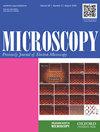Energy-dispersive X-ray spectroscopy for an atomic-scale quantitative analysis of Pd–Pt core-shell nanoparticles
IF 1.8
4区 工程技术
引用次数: 3
Abstract
The properties of core-shell nanoparticles, which are used for many catalytic processes as an alternative to platinum, depend on the size of both the particle and the shell. It is thus necessary to develop a quantitative method to determine the shell thickness. Pd–Pt core-shell particles were analyzed using scanning transmission electron microscopy (STEM) and energy-dispersive X-ray spectroscopy (EDX). Quantitative EDX line profiles acquired from the core-shell particle were compared to four core-shell models. The results indicate that the thickness of the Pt shell corresponds to two atomic layers. Meanwhile, high-angle annular dark-field STEM images from the same particle were analyzed and compared to simulated images. Again, this experiment demonstrates that the shell thickness was of two atomic layers. Our results indicate that, in small particles, it is possible to use EDX for a precise atomic-scale quantitative analysis. This article discusses the quantifi cation of EDX map acquired from Pd-Pt core-shell nanoparticles at the atomic scale. The EDX analysis provides that the thickness of the Pt shell corresponds to two atomic layers. The result indicates EDX is a great tool when studying core-shell nanoparticles.用于原子尺度定量分析Pd–Pt核壳纳米颗粒的能量色散X射线光谱
核壳纳米颗粒作为铂的替代品用于许多催化过程,其性质取决于颗粒和外壳的大小。因此,有必要开发一种定量方法来确定壳体厚度。使用扫描透射电子显微镜(STEM)和能量色散X射线光谱(EDX)分析了Pd–Pt核壳颗粒。将从核壳颗粒获得的定量EDX谱线与四个核壳模型进行比较。结果表明,Pt壳层的厚度对应于两个原子层。同时,分析了来自同一粒子的高角度环形暗场STEM图像,并将其与模拟图像进行了比较。这个实验再次证明了壳层的厚度是两个原子层。我们的结果表明,在小颗粒中,可以使用EDX进行精确的原子级定量分析。本文讨论了从Pd-Pt核壳纳米粒子中获得的EDX图谱在原子尺度上的量子化。EDX分析提供了Pt壳的厚度对应于两个原子层。结果表明EDX是研究核壳纳米粒子的一个很好的工具。
本文章由计算机程序翻译,如有差异,请以英文原文为准。
求助全文
约1分钟内获得全文
求助全文
来源期刊

Microscopy
工程技术-显微镜技术
自引率
11.10%
发文量
0
审稿时长
>12 weeks
期刊介绍:
Microscopy, previously Journal of Electron Microscopy, promotes research combined with any type of microscopy techniques, applied in life and material sciences. Microscopy is the official journal of the Japanese Society of Microscopy.
 求助内容:
求助内容: 应助结果提醒方式:
应助结果提醒方式:


